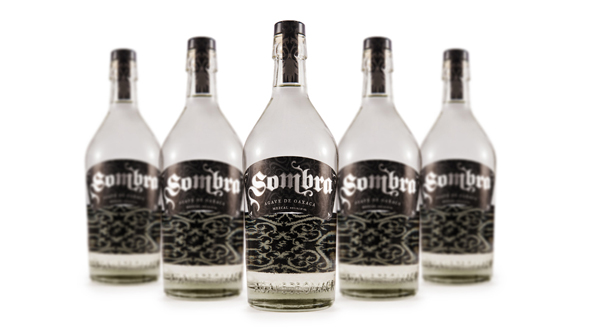
Ah, Mezcal… The smokey nectar of Oaxaca. After centuries of production, Mezcal is finally beginning to capture the public eye and make a name for itself on an international level. Although Tequila is technically the “National Drink of Mexico,” Mezcal, with all of its history is, and always will be, the real drink of Mexico.
First things first, let’s get the facts straight. Tequila is also a Mezcal, but not all Mezcal is Tequila. Mezcal just generally translates into a distillate made from Agave. Tequila and Mezcal can be compared in the same way as Scotch and Bourbon: there are similarities, but there is a vast difference between the production and the distillation techniques. The quirky and individual attitude of each Mezcal is something that you will hardly find in Tequila.
Tequila is a highly commercialized product that is made from Blue Agave (by law 51-100% of the product must be Blue Agave, with nicer tequilas only using 100%). Tequila is mainly made in Jalisco, the state surrounding the town of Tequila, with some limited production in other states. While there are some artisanal Tequilas that are worth noting, most Tequila can be summed up as a homogenized spirit that may or may not have seen time in an oak barrel. Tequila as a whole is mass-produced and is meant for easy drinking; it lacks a significant amount of flavor. During production, the piña (the juicy heart of the Agave plant) is baked and then shredded or mashed with a large stone wheel, called a tahona, to extract its juices. The juice is then fermented and is distilled twice. The differences in designations of Tequila (Blanco, Reposado, Anejo, Extra-Anejo) are all related to the amount of time Tequila ages after distillation.
Mezcal, with all of its intricacies, is like a conversation that never ends. One surprising fact about Mezcal is, unlike Tequila, it is meant to be consumed or released directly after distillation and traditionally does not allow aging in barrels. Mezcal is commonly distilled in Oaxaca and is made most frequently from Agave Espadin, but there are many other types of Agave used such as Tobala, Tepazete, Madrecuixe, etc. All of these variations of Agave can be distilled singularly or blended, resulting in unique, aromatic, and taste profiles. Mezcal Vago and Del Maguey, as well as some other brands, distill single varietal artisanal Mezcal. The scarcity of some of these comparatively less accessible varieties of Agave adds collectible value and fuel to the new wave of Mezcal hype.
One big important step in the process of Mezcal production is that the agave piña has to be roasted in a stone pit or clay pot with a wood-burning fire; this adds the traditional Mezcal smoke akin to peat in Scotch. This smoked flavor can be more or less distinct depending on where the Mezcal comes from, what kind of wood is used, and how long the piña is roasted. The juices are collected, fermented, and distilled twice like Tequila.
While Mezcal and Tequila have basic technical differences and similarities, Mezcal has a history and unique features that make it so valuable and rare. First: agave, also called maguey, is a succulent that can take anywhere from six to twenty years to mature, depending on its type. Mezcal itself is almost always produced in a small village by Mezcaleros, who search for wild agave. There is only a limited amount of wild six to twenty year old plants. Does that mean that the open availability of Mezcal will soon come to an end? Yes. Most producers do not plant agave; they merely consume it. Mezcal could disappear quickly, especially the most rare varieties, so hurry up to buy it now! In contrast, blue agave used in tequila is planted like vineyards and doesn’t take nearly as long to grow, your Cuervo is here to stay.
Second: there are some really authentic variations of Mezcal. Two in particular come to mind, Conejo and Pechuga. Both are made by Pierde Almas and come in at around a whopping $100-$400 a bottle. For those who don’t speak Spanish, Conejo and Pechuga translate into rabbits and chickens. The translations refer to the unique “tradition” that some select villages have adopted while distilling the spirits. These types of Mezcal are distilled with a dead rabbit or chicken hanging over the still. This is said to impart the spirit of the animal in to the distillate. Some versions of the Conejo and Pechuga are also said to include dried fruits and vegetables in the distillation process as well. The unique and quite unusual production process is regarded as a blessing to the season’s harvests and hunts.
Third: Mezcal was historically the villagers’ drink and it was what they called their own alcohol long before the Spanish taught them how to distill years ago. The Mexican people saw agave as a versatile life-giving gift, an “elixir of life,” and they worshiped it. There are countless legends involving Mezcal as the favorite drink of gods and goddesses. Mezcal has deep roots in Mexican culture and history; so, even though in the states we are just starting to hear about Mezcal, Tequila is much “younger” than Mezcal.
Looking at the San Francisco bar scene, Mezcal is climbing its way to the top and finding its way to the cocktail lists of all the best bars. Substituting Mezcal for Scotch or whiskey in cocktails is a great way to re-imagine old classics. If you haven’t tried an Oaxacan Old Fashioned (Mezcal, mole bitters, agave, a splash of soda and an orange peel), you haven’t lived yet. Make your way down to your fancy neighborhood cocktail bar and ask for one. Not all of the Mezcal variations are collectible items, and some conscious producers, such as Sombra, make great products that can be perfect choices for cocktails at a reasonable price. Sombra is one of the few producers that take care to replant the rare agave succulents and make sure that Mezcal is a sustainable product.
San Francisco continues to reinvent the wheel and give beverage geeks a new reason to be excited. There is a saying in Mexico, “Mezcal is meant to be kissed; not shot,” and cocktails are definitely one of the many ways to enjoy Mezcal. Mezcal sipped neat or on the rocks is quite lovely. Ice or a splash of water help bring out the unique character of some of the smaller production bottles. In the future, if you have a dilemma on how to truly enjoy your Mezcal, keep in mind the classic Mexican proverb, “For all good, Mezcal; for all bad, Mezcal.”
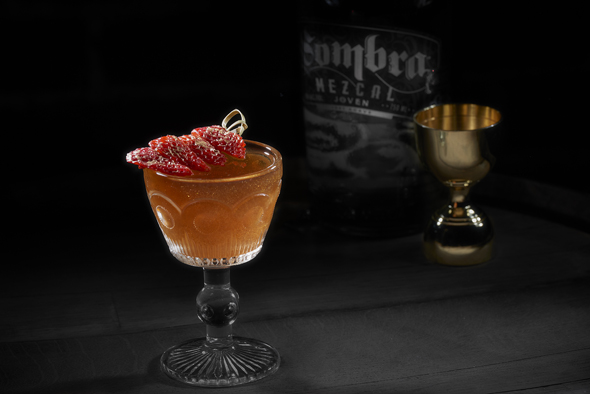
Orange cocktail
2 oz Sombra mezcal
1/2 oz lime
1/2 oz orange agave
2 shakes Sal de gusano
1/2 oz orange juice
edible gold garnish
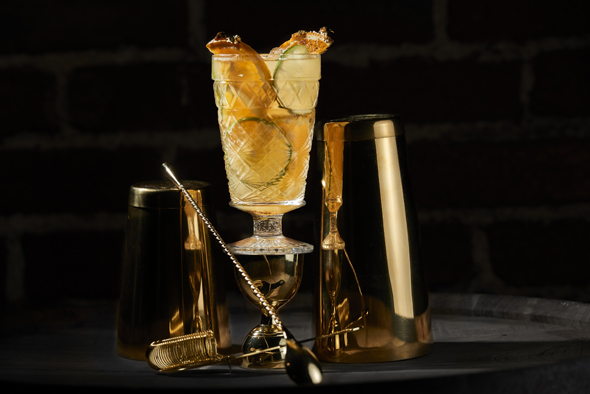
Strawberry cocktail
1 1/2oz Anejo mezcal
1/2oz Sombra mezcal
3/4oz Sweet vermouth
One dash mole bitters
One dash strawberry tincture
3 Shakes of gold dust
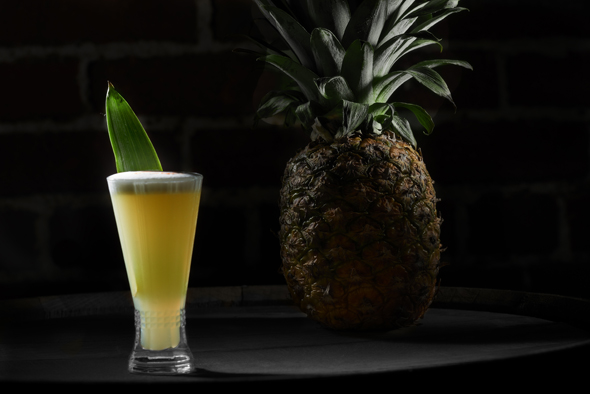
Shot cocktail
1 oz spicy tomato juice mixed with
mexican beer with a cheeky of
Sombra mezcal, and Guinness.
1/2 oz pineapple
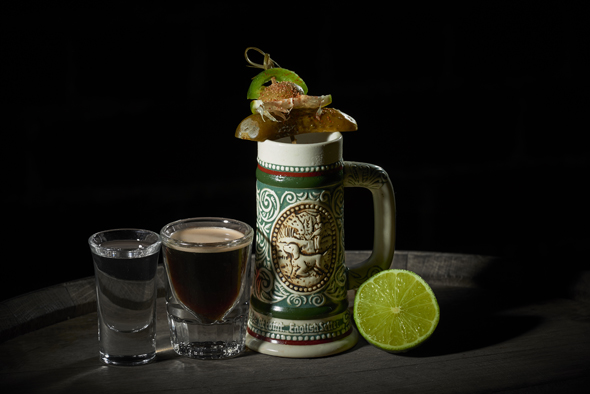
Pineapple cocktail
1 1/2 oz Sombra mezcal
1/2 oz green chartreuse
1/2 oz pineapple gum
1/2 oz lime
egg white
2 dashes of angostura
1/2 oz pineapple
Text by Jennifer Esterez, Marina Chilingaryan and Rohini Moradi
Recipe by Luis Ramos and Rohini Moradi
Photography by Herbert Damien

